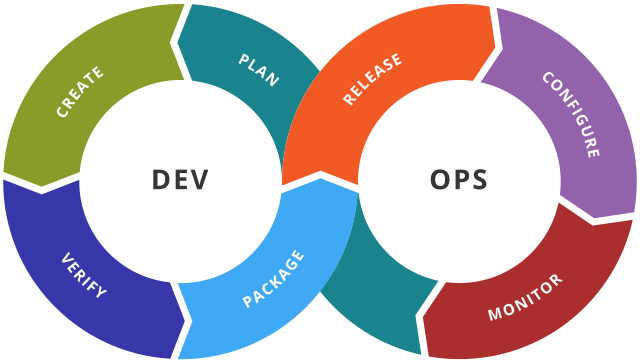
What is DevOps?
DevOps, short for Development and Operations, is a set of practices that aim to automate and improve the collaboration between software development and IT operations. It’s a culture and a set of processes that brings together the traditionally siloed functions of software development and IT operations into a streamlined and efficient pipeline.
When…?
DevOps emerged as a response to the challenges of the traditional software development lifecycle, where development and operations teams often worked in isolation. The need for faster and more reliable software delivery in the era of continuous integration and continuous delivery (CI/CD) fueled the rise of DevOps.
Where…?
DevOps is applied across the entire software development lifecycle, from planning and coding to building, testing, and releasing, all the way to deployment and monitoring. It transcends geographical boundaries, being adopted by organizations worldwide.
Who…?
DevOps involves collaboration between software developers, quality assurance professionals, and IT operations staff. It requires a cultural shift that encourages open communication, collaboration, and shared responsibility among these traditionally distinct roles.
Why…?
The primary goal of DevOps is to accelerate the delivery of high-quality software, ensuring a more reliable and efficient development and deployment process. It aims to break down barriers between development and operations teams, fostering a culture of collaboration and continuous improvement.
Which…?
DevOps involves the use of various tools and technologies to automate and streamline processes. Popular DevOps tools include Jenkins, Docker, Kubernetes, Ansible, and Git, among others. The choice of tools depends on specific organizational needs and preferences.
Whose…?
DevOps is not the exclusive domain of any particular industry or organization size. It has been successfully implemented across various sectors, including finance, healthcare, e-commerce, and technology. From startups to large enterprises, organizations of all sizes benefit from adopting DevOps practices.
Delving Deeper into DevOps
Understanding the Core Principles
DevOps is guided by several key principles:
- Collaboration:
- What: DevOps promotes collaboration between development and operations teams.
- Why: Collaboration reduces silos, enhances communication, and fosters a shared sense of responsibility.
- Automation:
- What: Automation of repetitive tasks throughout the software development lifecycle.
- Why: Automation improves efficiency, reduces errors, and accelerates the delivery pipeline.
- Continuous Integration (CI):
- What: Continuous integration involves automatically integrating code changes into a shared repository.
- Why: CI helps identify and address integration issues early in the development process.
- Continuous Delivery (CD):
- What: Continuous delivery extends CI by automatically delivering code changes to production-like environments.
- Why: CD ensures that software is always in a deployable state, ready for release.
- Continuous Deployment:
- What: Continuous deployment takes CD a step further by automatically deploying code changes into production.
- Why: Continuous deployment streamlines the release process, minimizing manual intervention.
Addressing Common Queries
1. What are the key benefits of implementing DevOps?
- What: The benefits include faster delivery, improved collaboration, reduced time to market, and increased reliability.
- Why: DevOps optimizes the software development lifecycle, resulting in tangible business advantages.
2. Which DevOps tools are widely used in the industry?
- What: Popular DevOps tools include Jenkins, Docker, Kubernetes, Ansible, Git, and more.
- Why: These tools automate tasks, enhance collaboration, and facilitate continuous integration and delivery.
3. Whose responsibility is it to implement DevOps practices?
- What: DevOps is a shared responsibility among development, operations, and quality assurance teams.
- Why: Collaboration and shared responsibility are fundamental to the DevOps philosophy.
4. Where can organizations implement DevOps?
- What: DevOps can be applied across the entire software development lifecycle, from planning to deployment.
- Why: Implementing DevOps throughout the lifecycle ensures a holistic approach to software delivery.
5. What role does culture play in the success of DevOps?
- What: A DevOps culture emphasizes collaboration, communication, and a focus on continuous improvement.
- Why: Cultural alignment is crucial for breaking down silos and fostering a collaborative environment.
Navigating the DevOps Landscape
Common Challenges in DevOps Implementation
1. Lack of Cultural Alignment:
- What: Resistance to cultural change can hinder the adoption of DevOps practices.
- Why: A cultural shift is fundamental to the success of DevOps.
2. Tooling Challenges:
- What: Selecting and integrating the right tools can be challenging.
- Why: Tools are a crucial element of DevOps success, and choosing the right ones requires careful consideration.
3. Limited Automation:
- What: Insufficient automation can lead to bottlenecks and delays.
- Why: Automation is a key principle of DevOps, essential for achieving speed and efficiency.
Overcoming Challenges
1. Emphasize Cultural Change:
- What: Prioritize cultural alignment through training, communication, and leadership support.
- Why: A DevOps culture is the foundation of successful implementation.
2. Conduct Tooling Assessments:
- What: Evaluate and choose tools based on organizational needs and goals.
- Why: Effective tools streamline processes and enhance collaboration.
3. Invest in Automation:
- What: Identify areas for automation and invest in the necessary tools.
- Why: Automation accelerates the delivery pipeline and reduces manual errors.
Conclusion
In the dynamic landscape of software development, embracing DevOps is not just a trend but a necessity for organizations striving for agility, speed, and reliability. The “What, When, Where, Who, Why, Which, and Whose” of DevOps provides a comprehensive overview, addressing common queries and guiding organizations on their DevOps journey. As organizations navigate the DevOps landscape, understanding its principles, benefits, and challenges is paramount to successful implementation.
Whether you’re a seasoned IT professional or a curious newcomer, embracing DevOps is not just an option – it’s a strategic imperative in today’s fast-paced digital era. The transformative power of DevOps lies not only in its principles and practices but in its ability to reshape the very fabric of how software is developed, delivered, and maintained.
Remember, the journey to DevOps excellence is ongoing, marked by continuous improvement, collaboration, and a commitment to delivering value to end-users with speed and efficiency.
More Related Blog

What is COTS Products, Tools and Integration (Updated JAN 2024)
COTS (Commercial Off-The-Shelf) products and tools are pre-built software components that are available in the market for purchase or licensing....
Read More
Why So Many Searches for Free Spy Apps: Unraveling the Intrigue
In today’s digital age, the internet has become a vast ocean of information, where curious minds can dive deep to explore a wide array of topics. One topic that has piqued the interest of many is the search for free … Continue reading "What is DevOps, Devops Tool, World of DevOps – A Comprehensive Guide"...
Read More
Successful DevOps adoption for Quality Assurance – Know it all here
Let’s understand the fact that successful DevOps adoption will need an efficient team of DevOps experts who will always be ready to support you with the most needed expertise in technology and tools. They will deal with and manage all … Continue reading "What is DevOps, Devops Tool, World of DevOps – A Comprehensive Guide"...
Read More
